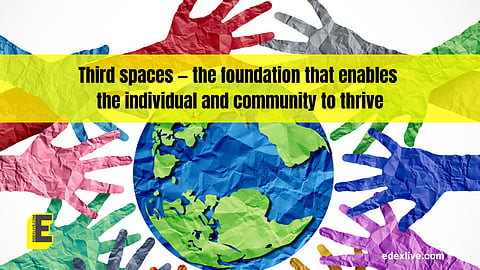

From the agoras of ancient greece, to the chaupal in the local village, to the thriving community on Marine Drive, third spaces have been at the heart of societal flourishing. These are spaces and structures that connect us to others.
What is a third space? A space that is neither home, nor work or school, a liminal space. A space all kinds of people share. Where lots of different things happen. A space that belongs to everyone and no one. Not everyone knows each other, but it creates a certain familiarity.
Third spaces provide the foundation for deep and broad connections across a community, a shared space for civic dialogue and civic action, and a way for people to expand their identities.
Inequality is growing, discourse is increasingly polarised, violent conflict is rising across the world. Medical advances, technology, and infrastructure have improved life exponentially for everyone from just 100 years ago - no matter where you are in the pyramid.
And yet, we’re seeing skyrocketing rates of mental illness and suicide.
In today’s insta-world, we go days and weeks without engaging with people who aren’t just like us. We go to work with our colleagues from similar domains and not dissimilar backgrounds, plus we mostly talk shop. Back home — family is comfort; sharing our world view and our history. Most of our friends come from similar circles to ours. Even groceries arrive at our door through Instamart or Zepto.
We don’t have to speak to the uncle at the kirana store. We spend our days and weeks doing broadly the same thing on repeat. Is it any wonder that we often feel bored, stuck, or just a sense of languishing? Loneliness can increase our risks of heart disease by 29%, stroke by 32%, and dementia in older adults by 50%. Society is not thriving.
It is no coincidence that this unravelling of society correlates with the dismantling of democratic public spaces. With the commodification of land and time, such spaces are rapidly disappearing — chai tapris are replaced by a Swiggy delivered coffee, parks are taken over by slightly wider roads, and community halls bought over by developers.
In a global survey, only 5% of respondents felt that public spaces met their community’s needs.
Several movements in India are reclaiming the fundamental need to connect and share space; The Steps Bandra is a community led movement, which has brought a new lease of life to the steps around Mount Mary, hosting skate events, art, dancing, and food stalls.
Some events require months of coordination (like the wonderful Steps Festival), but others are simpler — a bunch of people show up, and share their skills and passions. Even the simplest activity requires faith that the community will show up, and a trust-based collaboration with local authorities.
We’re seeing a rise of loosely organised, digital communities spilling into the physical world. Book clubs on WhatsApp, or Discord communities for art or gaming — most of the engagement is on phone, but a monthly meet up turns these tiny sparks into full blown connections.
These don’t need any capital, nor a particular role title. They’re sparked by a couple of enthusiasts, and turn into communities as people choose to show up and share their interests too.
Dharohar, an Udaipur based NGO, has been carefully creating spaces to bring people out of the comfort of their home to a space shared with others. Whether through the redevelopment of local public parks such as Nyay and Udaan, or through the larger scale “Third Space” — a 14,000sq m haveli of curiosity, connection, and creation, it creates, safe, joyful spaces where young and old, scientists, artists and sportspersons, rich or poor, can come together.
From architecture to programming to facilitation, each facet is designed to be inclusive, varied, and focused on connections. At monthly Art Jams, folks bring their own materials or instruments, sketch, paint, or make music together.
A community has sprung up at the Third Space climbing wall — ranging from college students, to a young girl with a professional trainer, to those using it to let off steam after a hard day’s work. They gather, cheer each other on, and share tips about technique. As they climb and draw, they become more connected to their community. They feel a sense of belonging and grounding where they are.
These are spaces where people put down their work or home identities - they’re not “daughter” or “data analyst”. People explore new identities; an introvert gives standup comedy a shot, a “party guy” may engage in thoughtful contemplation, and a scientist explores how clay feels in their hands.
And they do all this with people who have very different stories to their own. And in doing so, they become an integral part of the community in which they live. They start to own the space, and take action.
Third spaces are not difficult to create. A few catalysts are enough to spark them. They can, however, be challenging to sustain — they need a community of people to show up regularly, to welcome newcomers, and to shape their culture.
They start small, but grow into something powerful; a strong, wide web of connections, which leads, over time, to a healthier, more democratic, and thriving community.
(Shivani Singhal is the Chief Executive Officer (CEO) of Dharoha and a Teach For India (TFI) alumna.)
